|
It's genuinely hard to say anything about Bruce Robinson's now seminal Withnail & I that hasn't already been written a gazillion times over. Not by film critics, mind you; their detailed essays came later and were effectively summaries and interpretations of already widely expressed opinions. Like so many great cult movies, the film wasn't a hit on its initial cinema release, and only really found the sort of fervent popularity it now enjoys on home video. That's certainly where I and just about everyone I know who is a fan of the film (which is everyone I know, as it happens) first encountered it. Unlike my first viewing of some of the more life-changing films of my youth – 2001: A Space Odyssey, The Texas Chain Saw Massacre and the like – I genuinely cannot recall my first exposure to this film or the specifics of my reaction. But I must have enjoyed it. I bought it on VHS and twice on DVD, and distinctly remember inviting a work colleague that I never used to hang out with back to my place one evening because it was screening on Film 4, and I just knew it would get a reaction from him. It did. It always did.
So given my opening statement, how am I going to review the film? It's simple, really – I'm not, at least not in the traditional sense. The fact of the matter is that it's already been reviewed on this site by my fellow scribe Camus in his coverage of Anchor Bay's 20th Anniversary DVD release, and he's made the case for what makes the film so special more persuasively and inventively than I could ever hope to, and even made some of the very same points that I would have covered had the review fallen to me. You can read that review here, and it's worth doing so now if you're planning to read on, as my piece is effectively a follow-up, a personal reflection on the film and my gradual awakening to its growing cult status. It also assumes that you've seen the film at least once – not only are there a couple of spoilers ahead, but I'll be making reference to aspects of the film that I won't be furnishing with contextual explanations.
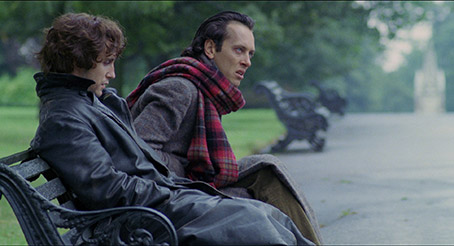
It was some time before I became aware that Withnail & I had garnered a cult following and just how far it had spread. In pre-internet days this was not exactly unusual. Now cult films are celebrated on fan-run web sites the world over, but back in the day you only realised a film had achieved cult status when you met a number of others whose enthusiasm for it matched yours, or if it became the subject of a detailed article in the sort of specialist film magazine you'd never find at the newsagent. I'd introduced the film to a number of people before I had my first inkling that the film's fan base had substantially grown. I was living in a shared house at the time, and an actor friend of ours had moved in for a few weeks, resting between jobs as the saying goes. I happened to mention that Withnail & I was screening on TV that night and his face instantly lit up. "Monty, you terrible cunt!" he bellowed with a roar of laughter. It was the first time that dialogue from the film had been thrown at me without prompting. It wouldn't be the last.
I'd always thought of Withnail as a particularly British film and tended to assume that it would only really work for a UK audience. I soon learned otherwise. A few years ago I was shooting a film directed by my humble writing colleague, one of whose two lead actresses was American. We were about halfway into the shoot before Withnail came up in casual conversation. Her response was instant and boisterously enthusiastic, and she was excitably quoting lines from the film at me for the rest of the evening. It was only recently that I became aware of how well received the film had been by the American press. Even those involved in the project seemed surprised by its reach. In his entertaining and tellingly titled film diaries, With Nails, lead player Richard E. Grant recalls his first meeting with Jodie Foster, who enthusiastically told him that she was a huge fan and had personally taken four different sets of people to see it.
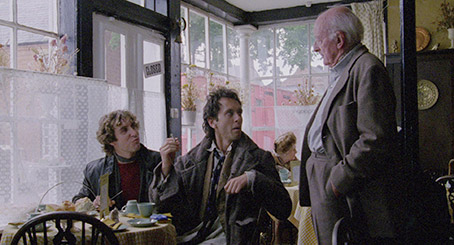
Over the years the film has become almost a badge of bonding, one that can launch cheerful conversations and give birth to long-term friendships. It's a film that those who fall under its spell don't watch once or twice, but twenty or thirty times without becoming weary of a single element. Fans know almost every line of dialogue well enough to instantly recognise where any of them originated should they hear them quoted by others. This is something I experienced again only recently. Having just re-watched the film in its gloriously restored incarnation (more on this below), I was at work the following day and happened to walk in on a colleague of mine. We've never really talked film (he's a musician, so that tends to lead the conversations), but we've always got on well and this seemed as good a time as any to have our first movie discussion. "We've gone on holiday by mistake," I suddenly blurted out for no reason. He laughed and instantly responded, "Flowers are essentially tarts – prostitutes for the bees." No introductory words, just two lines from a film that neither of us were aware the other had seen, and a jovial discussion on our favourite sequences from it was instantly instigated.
More than once I've tried to nail down exactly what it is about Withnail & I that prompts such an enthusiastic response from so many people. I know why it works for me, but my reaction has always felt so personal that I'm actually surprised so many others feel as passionately about the film as I do. There are some obvious reasons, principal among them being Bruce Robinson's screenplay, as brilliantly and beautifully crafted a piece of character writing as I've heard or read (seriously, listen to Camus on this one and get hold of the original screenplay if you can, it's an absolute joy). One of the reasons why every line in the film is so quotable is that the dialogue here is not only funny, but wickedly smart – stop laughing at it for a second and find yourself in awe of the thinking behind it. And if great dialogue only truly comes to life when performed, by thunder it soars here. There's little I can say about the perfection of the casting that hasn't already been chiselled on tablets and taken up the mountain, and it's the actors delivery of the lines, as much as Robinson's writing, that has made so much of the dialogue so quotable. This has effectively set every line in a cult-shaped stone, and ensures that when any fan of the film recalls their favourite quote, it's always in imitation of how it was delivered by the character in question. Even here we should still give credit to Robinson, who had very specific ideas about how certain lines were to be performed, a few of which – including the wide-eyed traffic cop's high-pitched screech of "Get in the back of the van!" – have become fan favourites.

As Camus rightly states in his original review, when just about every line is memorable in some way, you really don't take everything in on the first or even second and third viewings. Every time I watch the film (and I've seen it more times than is probably good for me now) I find something else to latch on to. So famous now are the more celebrated lines that I tend to anticipate their arrival and am now picking up on the almost throwaway moments, and even these are to be treasured. Last time I watched it, it was Withnail drunkenly pointing at a seat in the café in which one of his most oft-repeated lines is delivered and asking, "Alright here?" that had me giggling helplessly and repeating the line ad infinitum later (see it – you'll get it). The fact that he says it twice in exactly the same way, separated by "Cake" just seems to make it even funnier.
But I'm also fully aware that the film touches me in ways that go beyond my appreciation of great writing and acting. It was a famously autobiographical work for Robinson, a recollection and blackly comic distillation of his younger days sharing a flat with his close friend Vivian MacKerrel, on whom Withnail is directly based. It's this that, at least for some of us, provides an almost umbilical connection to the film and its characters. Certainly its popularity with students can be traced in part to the shared experience of shabby communal living, kitchens dominated by a mountain range of two week-old washing up, and the daily ingestion of copious amount of booze. But there's more. On a commentary that I otherwise had a few problems with (all is explained in the extra features below), writer Kevin Jackson claims that one of the reasons people connect with the film so enthusiastically is that we've all had a friend like Withnail at one time or another. While I question whether this is universally the case – I've met a number of people who find Withnail a joy as a tragi-comic character but shudder at the idea of spending time with any real-world equivalent – it was certainly true for me.
My Withnail and I never shared a flat (I genuinely think we would have killed each other), but our relationship was in other ways uncannily close to that of the film's two lead characters, or perhaps more accurately, that of Bruce Robinson and Vivian MacKerrel. Like Withnail and Vivian, my friend was also a heroic consumer of alcohol and at times was every bit as self-centred, arrogant and deluded about his life. His disregard for others and even his own safety when intoxicated would see him act on inebriated instinct with a complete lack of awareness of any real world consequences. When drunk in his company I tended to cheerfully follow his lead, sometime to my cost – how we avoided arrest or serious injury over the years is still a mystery to me. There were times when I genuinely wanted to kill him, and after a holiday together in Scotland in which excessive drinking drove a serious wedge between us, it was months before I agreed to even speak to him again. But in spite of all this, he was the smartest, funniest and most creative person that I have ever known, and I genuinely loved being with him or hearing tales of what he'd been up to in my absence. He was a kindred spirit, and at a time when the world seemed to offer nothing for directionless misfits like myself, it was only in his company that I felt truly alive.
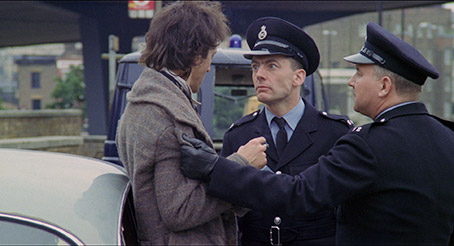
Things started to change when, after some years of Thatcher government-created hopelessness, I found a way out of the mire that for some time had shaped my life. Our friendship remained utterly crucial, but was now no longer the dominant factor, and we began to see less of each other. It's this point in such a relationship that Withnail & I seems to perfectly capture, when the frustrations of the bond between Marwood and Withnail begin to outweigh its previous pleasures, and an escape route presents itself that looks set to unshackle Marwood from that part of his friendship that has prevented him from moving forward. There's a sadness in that rightly celebrated final scene that really hits home due to a sublime combination of performance and direction. When Marwood and Withnail each say that they'll miss the other there's a sincerity that never fails to bring a lump to my throat. Their parting hurts because, like Marwood, when I was able to move on I effectively abandoned my own Withnail to his fate. It was not a happy one. Robinson may have oh-so-wisely abandoned his original ending, in which Withnail uses a wine-filled shotgun to take his own life, but you're still left with the impression that without hope and without his good friend, this "trained actor reduced to the status of a bum" is unlikely to make out alive. My Withnail didn't. His ending differed from the one written by Robinson only in its method, and I still miss the awful bugger badly all these years after we said our last goodbye.
I can't be rational about Withnail & I and don't see why I should be. It's sublime cinema, a pitch perfect character study that's simultaneously both poetic and real, and an exquisitely devised and executed black comedy that just seems to get better with every viewing. If you've never got around to seeing it then you're in for a treat, and if you've only seen it five times or so then take it from me, there's still so much more in there to discover.
| How to Get Ahead in Advertising |
|
Technically this is an extra feature, but how can I seriously treat it as such? It's Bruce Robinson's second feature film in its entirety, on its own disc and also the result of a careful restoration, so deserves its own section.
Despite attracting some favourable reviews on its initial release, this second collaboration between Bruce Robinson and leading man Richard E. Grant was never really destined to attract the same fervent following as their extraordinary debut feature. Quite aside from the sophomore curse that seems to afflict so many directors who make a splash with their first film (albeit in this case, a splash that took several years to coat the patio with water), How to Get Ahead in Advertising is a film born of political anger rather than personal experience, one driven more by fears of the present rather than memories of the past. Where we empathically bonded with Marwood, his friendship with Withnail and their desperate need to escape their all too recognisable squalor, in this follow-up feature there is no such point of contact. The world in which it is set is an alien one to most of us, and its central character is initially a dick of the lowest order. So it's a disaster, right? Not in the least. It's no masterpiece, sure, and coming back to the film after a gap of several years, I'm reluctant to even suggest it's fully satisfying work. But it's still a fascinating, ambitious and consistently imaginative assault on the shallow and corrupted face of modern, corporate Britain and the sort of rampant and amoral commercialism that is depressingly back in vogue.
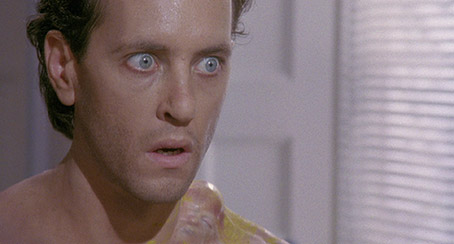
Denis Dimbleby Bagley is a ruthlessly talented advertising executive who believes that everything worth having has a price tag on it and that there's always a way to sell it to a gullible buying public. There's apparently nothing this man can't flog, that is until he's charged with devising a campaign to sell a new boil removal cream, the stress of which prompts him to turn his back on the advertising world and everything he previously claimed to believe in. It also gives birth a large and ugly boil on his shoulder, one with a face and a confrontational personality, all of which sets Bagley on the road to madness.
The sheer speed with which Bagley's transformation takes place is a little disorientating, occurring too rapidly to make complete narrative sense and too early for us to have formed any sort of bond with him, other than that of a kid with a magnifying glass observing a particularly odious bug. But then this is satire not social realism, one whose purpose becomes clear once Bagley starts doing battle with the boil for the possession of his soul. What's fascinating about this conflict is that while our sympathies lie with the hapless Bagley, his awakening to the deceptive evils of advertising is seen by those around him – and in some ways by the film itself – as irrational to the point of madness. Wide-eyed and wild, he rants while others remain calm and superficially rational, talking sense in a manner that comes across as a demented rant. That the boil only talks when he is alone or Bagley's face is hidden only serves to convince everyone that he's lost his mind. And maybe he has. Is the boil a genuine physical manifestation or are we watching events entirely as Bagley's twisted mind sees them? Or is the entire battle a purely metaphorical one, a physical representation of Bagley's struggle between his amoral greed and the underlying horror at what he does for a living?
It's a potent collision of political satire and body horror, albeit one whose bite is sometimes dulled by the volume at which it is pitched. There's a real sense that Robinson encouraged Grant to throw caution to the wind here and to hell with the consequences, which occasionally takes the film to the brink of hysteria, from which it somehow always manages to pull back. And from an acting standpoint it's Grant's show all the way, a showcase for the extremes to which he can be pushed, but also for his skill at delivering great monologues (as far as I'm concerned, his opening speech to a room full of advertising hopefuls is up there will Alec Baldwin's lambasting of the luckless salesmen in Glengarry Glen Ross). And when the boil becomes the dominant voice, Grant displays a talent for smarmy villainy that has remained strangely untapped in the subsequent years.
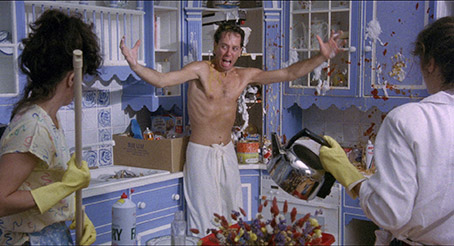
How to Get Ahead in Advertising may be flawed, overstated and frustratingly scattershot in its approach and execution, but it's too damned inventive and interesting to be dismissed as an also-ran in the careers of either its director or its underused lead actor. It takes risks by the dozen and if it sometimes trips, then we'll take that on the chin because at least it tried, dammit. And despite all that, it intermittently scores with such thrilling precision that makes you wish that Robinson had subsequently been given a ton of money and encouraged to make whatever he wanted without outside interference. There really is nothing else out there quite like it, and at a time when art has once again been engulfed by the corrupting force of commerce, we need films like this, ones that shout their warnings from the rooftops and take no prisoners in their depiction of a world that has sold its soul to the Devil for the price of a new car, a condo and a holiday in Dubai.
It's unfortunate for Withnail & I that so many of us first encountered it on VHS or a TV screening, which conspired to convince us that this was one of the grubbiest looking British films of the modern age. The early DVD releases did little to contradict this, and even Anchor Bay's 20th Anniversary Edition didn't exactly sparkle. This, we concluded, was how the film was meant to look. Rarely have I been so delighted to be wrong. This transfer has been restored from a 2K scan of the original negative under the supervision of James White at Deluxe Digital. Thousands of instances of dirt, debris and scratches have been removed and the transfer was graded under the supervision of the film's director of photography Peter Hannan. The result is an absolute revelation. Yes, there are a few darker shots where the grain appears to take a temporary leap in coarseness, but in all other respects the film is transformed from its previous home video incarnations. The clarity of the image and level of visible picture detail initially convinced me that my new glasses were functioning better than I had ever expected, but it doesn't end there. On sequences where the lighting allows (those that are not set in darkened rooms or lit by lamplight), the contrast range is sublimely rendered, the flesh tones beautifully captured, the black levels crisp and the colours naturalistic, with the pastel tones of some of the set dressing gorgeously rendered. As you would hope from such a restoration, there's hardly a mark to be seen anywhere, and the image is consistently stable in frame. Penrith and Cumbria look every bit as lovely as they do in real life. A marvellous job.
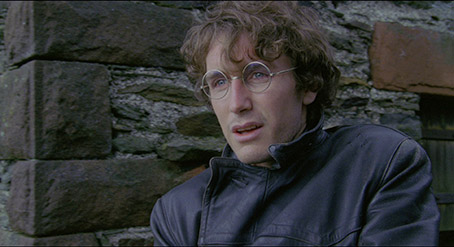
The Linear PCM mono track has also been cleaned up and sounds terrific. The dialogue and effects are clearer here than they have on any of the previous home video incarnations and there is no trace any previous damage or background distractions.
How to Get Ahead in Advertising has also been restored, and while not quite as gobsmackingly gorgeous as the Withnail transfer it still looks damned good. Framed 1.85:1, the grain is more prominent here and the contrast range slightly less generous, but the picture is spotless, the colours largely naturalistic (a lamp lit dinner party has a deliberately warm hue) and the level of detail is strong.
The Linear PCM 2.0 stereo track is in very good shape, and really comes to life with the video shoot performance of My Generation, though there is a slight treble leaning to the music here.
Commentary by Bruce Robinson
A port from the 2009 Anchor Bay DVD, the track is hosted by the wonderfully named Carl Daft, who most effectively prompts Robinson for his recollections on the making of the film. Almost all of the most famous stories of the shoot are retold here, including the substitution of vinegar for water in the lighter fluid drinking sequence, how Grant's performance of the line "Fork it!" in his audition landed him the role, executive producer Denis O'Brien's horror at the first rushes, the inspiration for Danny the dealer's voice, and a whole load more. A number of real-life stories that inspired scenes of the film are recalled (drinking lighter fluid apparently rendered Vivian temporarily blind), information is provided on the shooting of specific sequences, and Robinson even points out a continuity error that drives him potty to this day. And this is just a sampling. Excellent stuff. A shame we don't also have the Paul McGann and Ralph Brown one from the same DVD, but that gives you a solid reason to hang onto that disc.
Commentary by Kevin Jackson
I'm sure that inviting the author of the BFI Classics book on Withnail & I to record a commentary must have seemed like a great idea, but what we effectively get is a one man laughter track. OK, I'm exaggerating a little, but Jackson does spend way too much time just laughing at the dialogue and repeating favourite lines, which wouldn't be so annoying if most of the information he does provide wasn't covered in more detail and from a more interesting insider's angle in Robinson's commentary. The odd few interesting titbits are delivered, but these could have been covered in a five minute interview. I have no doubt that this will work rather well enough for some, but I frankly had trouble staying with it to the end. One thing I was surprised by is Jackson's reaction to the famous café scene, which he believes is out of character for Marwood because he behaves as badly as his friend. For me this element is crucial, as it's the one time in the film when the two are both drunk in a non-threatening situation, and what we briefly see here is the friendship that kept them together for so long, one in which alcohol was able to unleash the mischievous nature of both. Watching this scene I can see myself and my own Withnail captured to perfection. If only we were half as witty when we were rat-arsed.
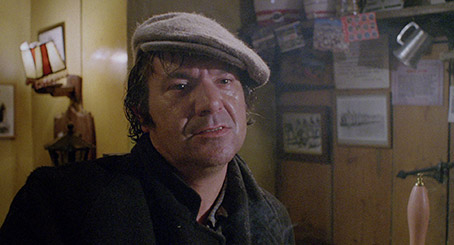
The following four extras are collected under the banner Withnail Weekend Documentaries, having all been screened as part of Channel 4's Withnail Weekend in 1999.
Withnail & Us (25:01)
Using the letters of Withnail's name as tenuous chapter titles, this interview-led look back at the film's production talks to a number of those involved, including Bruce Robinson, Richard E. Grant, Paul McGann and Ralph Brown. There's inevitably some crossover with the documentary, but this is still enthralling stuff, and the inclusion of 8mm home movie footage of Vivian MacKerrel and a young Bruce Robinson makes it an invaluable inclusion.
The Peculiar Memories of Bruce Robinson (38:58)
A compelling and revealing portrait of writer-director Bruce Robinson that takes us through his film career in satisfying detail, from his early acting gigs for Franco Zefferelli and François Truffaut through the production of Withnail & I and How to Get Ahead in Advertising (which Robinson describes as having "too much rant and not enough movie"), and his experience in Hollywood with Jennifer 8. The meat of the documentary is the interview material with Robinson himself, who reveals that he prefers to be three sheets to the wind when writing because he expresses himself more freely, and that when his hands give out he will type with his nose. "I can exceed the speed limit," he says, "sometimes I can do ninety." Several of his collaborators are also interviewed, including Andy Garcia (star of Jennifer 8), Roland Joffe (director of The Killing Fields, the screenplay for which won Robinson a BAFTA) and producer David Puttnam, who concludes the piece by saying of Robinson, "In a way he's too good a writer for today's cinema. He hasn't got it in him to be a hack, thank God. He's too good."
I Demand to Have Some Booze! (6:00)
A group of students play the Withnail drinking game, which involves watching the film and matching Withnail on a drink for drink basis. Though I used to once be able to throw it back at a ferocious pace, I can only assume by the clarity of their speech at the end that they left the film on pause for extended periods. One of them even drinks some lighter fluid, news that horrifies an interviewed Richard E. Grant.
Withnail on the Pier (4:25)
In the run up to an open air screening on Brighton beach, fans of the film talk about what makes it so special and pick their favourite lines. Ralph Brown is also on hand to offer his own recollections.
An Appreciation by Sam Bain (8:04)
The co-creator of Peep Show and Fresh Meat, sporting the sort of three-shades-of-grey beard that decorates my face when I grow one, talks engagingly about his own love of the film and reveals that it was a key influence on the character setup of Peep Show.
Interview With Michael Pickwoad – Withnail & 1 (21:14)
The film's production designer has plenty of engaging memories of the shoot, including how he landed the job, locating and preparing Monty's cottage and set-dressing the flat. The kitchen, we are assured, was every bit as disgusting as it was portrayed in the film.
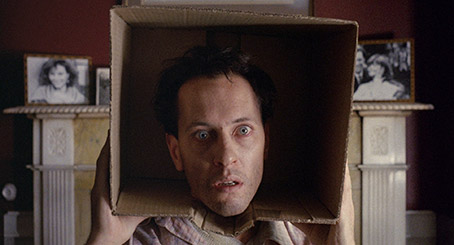
Interview with Michael Pickwoad – How to Get Ahead in Advertising (10:11)
Here Pickwoad recalls the process of set-dressing the advertising offices (Robinson worked at a couple and had specific ideas here) and the kitchen that Richard E. Grant gets to destroy, plus the process of finding a hill with a monument on it for the final scene.
Trailer – Withnail & I (1:26)
A grubbing and fuzzy trailer that includes a solid collection of favourite lines.
Trailer – How to Get Ahead in Advertising (1:53)
Another fluffy quality trailer, this one cropped to 4:3, that sells the film as fast moving farce.
Book
I know what you're thinking. He meant to write 'booklet' and mistyped. Not so. What you get with this package is a fully fledged book, 200 pages long (I'm including the covers) and absolutely jam-packed with worthwhile reads. As a literary companion to the film it's as good as any I've seen in a Blu-ray or DVD release, and provides so much information on the main feature and its principal cast and director, that it's almost in danger of taking the edge off of the excellent on-disc extra features, but in the end only serves to compliment them. Included are: an introduction by Bruce Robinson that was originally written for Bloomsbury's 1989 edition of the Withnail & I and How to Get Ahead in Advertising screenplays, and includes some lovely and heartfelt political anger; an entertaining essay on Withnail by Vic Pratt, writer, film historian and a curator of fiction film at the BFI National Archive; extracts from contemporary reviews of both films; reproductions from Bruce Robinson's original screenplay (read this and you'll be aching to get hold of the full thing) of six deleted scenes; a 1994 article from Loaded by James Brown (no, not that one) with the self-explanatory title, Withnail, You Terrible Cult, which includes details for the Withnail drinking game; a re-examination of the film from a 2014 perspective, also by Mr. Brown, titled A Terrible Cult Revisited; an enjoyable article on the film by David Cavanagh from Empire that is peppered with interview quotes from Robinson, Grant and McGann and titled You're My Bessht Friend!; a useful piece by disc and booklet producer Anthony Nield on Bruce Robinson's early work in front of the camera, titled An Actor Prepares; concise profiles of actors Paul McGann, Richard E. Grant and Richard Griffiths by Martin Jones, Neil Mitchell and Mike Sutton respectively; an essay on How to Get Ahead in Advertising titled If It Hasn't Got a Price Tag, It Isn't Worth Having by Frank Collins; main credits for both films and some of the extras and details of the transfers. Superb.
A favourite film, beautifully restored and packed with some fabulous extras. OK, so one of them didn't work for me, but given that the release also includes Robinson's second feature, fully restored, some excellent documentary material and a book so substantial I'd be prepared to pay money for it were it released as a stand-alone product, I'm in no way complaining. Working from the review discs and a PDF of the book, I've not been able to comment on the packaging of the final release, which looks so lovely that I've ordered a copy anyway because the version I have feels incomplete without it. An absolutely bloody gorgeous release that every fan of the film should own and treasure. Thank you, Arrow Films and Video.
|